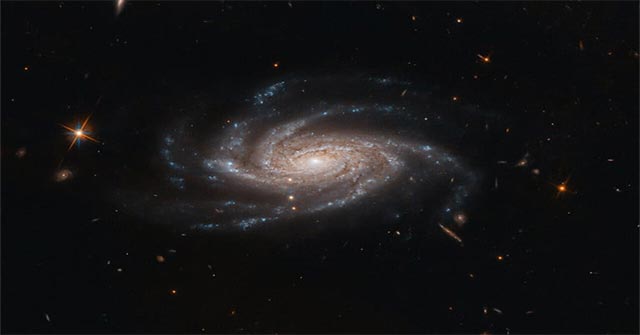Admire the latest Hubble masterpiece
Looking closely at the image, it is not difficult to see the glowing nuclei at the center of the galaxy, with stars and dust reaching out from here, forming beautiful spiral ridges. From this perspective, it is possible to imagine NGC 2008 as a super typhoon sweeping through the abyss, with the eyes of the giant stars shining brightly.

A common feature of all spiral galaxies is the appearance of twisted 'arms' with an almost identical structure and size extending from the center of the galaxy. In this case, because the NGC 2008 galaxy is in a slightly inclined position compared to the view from Earth, so the spiral arms at the bottom of the galaxy that you see in the image will be near the Earth. than the upper arms. These arms are made up of scattered bright spots that are the star-forming region. This is where gas clouds are ionized by gravity and form the basis of new stars. The ionized gas reacts to Hubble's infrared light due to the heat generated by the stars inside it, creating the cold, bright spots we see on the image.
There are 3 different types of spiral galaxies: Sa, Sb and Sc. Sa are galaxies with arms close to a large central nucleus, while Sc galaxies have long, thin arms, spread out from a smaller nucleus. Galaxy Sb is a combination of Sa and Sc.
NGC 2008 is a Sc galaxy, with a smaller central core and clearly visible ways of changing helices. The center of the galaxy is composed of older, fainter stars, and in most cases they surround a supermassive black hole at the center of the galaxy.
The spiral galaxy is one of the most common galaxies in the universe, with about 70% of the total number of galaxies observed by humans in the form of spirals. Our galaxy, the Milky Way, is also a spiral galaxy, but it possesses a feature different from that of NGC 2008: In the center of the galaxy there is a mass of dust and gas in the new stars. forming and from which the arms radiate. About 2/3 of spiral galaxies possess this feature.
Some other famous spiral galaxies include the Andromeda galaxy, Pinwheel galaxy and Triangulum galaxy.
You should read it
- Admire the special image of galaxy NGC 3175 taken with the Hubble space telescope
- Lonely star glitters in the background of an amorphous galaxy in the eyes of the Hubble telescope
- Detecting UGC 2885, a giant spiral galaxy, 2.5 times larger than the Milky Way galaxy
- Admire the image of the strange jellyfish galaxy through the eyes of the Hubble telescope
- Leaked the first real image of Samsung Galaxy S11, the most anticipated smartphone in the first half of 2020
- The moment two galaxies collide in a super rare image taken by the Gemini North telescope
- Samsung Galaxy S10 will have 3 versions and this is the latest leaked image of this popular flagship model
- Samsung will integrate eSIM technology on Galaxy S20 Ultra
- Galaxy S11 5G officially appeared on Geekbench with impressive specifications
- Order Galaxy S20 series and receive Galaxy Buds + headphones for free
- How to take RAW photos on Galaxy S8 / S8 Plus
- Review Galaxy M51 camera : Quality image bold and full of attraction
May be interested

The Windows 10 KB4532693 update fails, causing a user's file to be deleted

How much electricity does your phone charge plug in constantly when not in use?

Google Pixel 5 XL: First leaked images

LG and Samsung are developing a 'separate screen' specifically for smartphones

The Galaxy Z Flip is out of stock in Korea 'in a single note', forecasting out of stock in the US

Let's look back at all the iPhone generations Apple has launched over the past decade





 Shocking discovery from Hubble: Giant space target with 9 swirls
Shocking discovery from Hubble: Giant space target with 9 swirls Admire the image of the strange jellyfish galaxy through the eyes of the Hubble telescope
Admire the image of the strange jellyfish galaxy through the eyes of the Hubble telescope Admire the special image of galaxy NGC 3175 taken with the Hubble space telescope
Admire the special image of galaxy NGC 3175 taken with the Hubble space telescope The day you were born, is there anything special about space? NASA will help you observe with Hubble
The day you were born, is there anything special about space? NASA will help you observe with Hubble Hubble telescope discovers more than 1,000 new asteroids
Hubble telescope discovers more than 1,000 new asteroids The Hubble Telescope sent back to Earth its first photo after changing its operating method
The Hubble Telescope sent back to Earth its first photo after changing its operating method